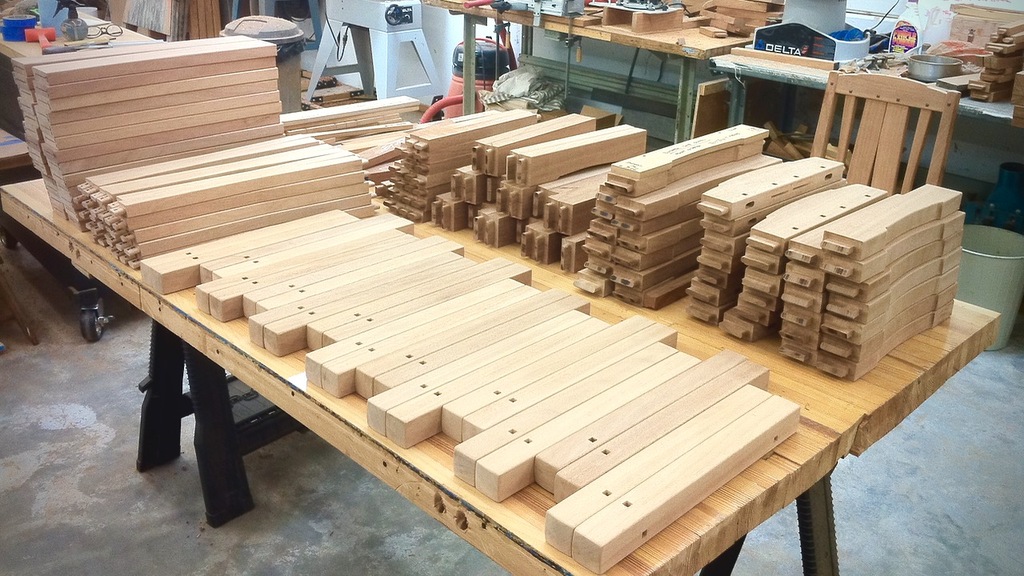We may receive a commission when you use our affiliate links. However, this does not impact our recommendations.

A lot goes into making a stack of parts. Besides measurements, organizing your parts is an important part of being a successful woodworker. These are stacks of parts used to make a dozen dining chairs.
Part Two: Commitment
To be successful as a woodworker, either hobbyist or professional, precision needs to be a standard you set that you’re willing to live by. Professionals have obvious reasons to do this as their success is at least partially measured by efficiency with time and materials. If you mess up, mistakes are measured in time and $, so an important part of being a professional is committing to working efficiently and precisely. A hobbyist may be inclined to think that precision isn’t as critical, but they’d be wrong. The very definition of a hobbyist — particularly one who has a job and bears the numerous responsibilities of modern family life, points to the limited time available to dedicate to your woodworking passion. Simply put, you likely have even less time and financial resources to apply to your craft than professionals. Mistakes, inefficiencies, and delays, caused by lack of precision and poor processes result in a high cost in your limited time and money.
Setting Standards
So, where do you go from here? How do you incorporate and use precision into your woodworking? Let’s list a few. Certainly, there are more, but these are the first details for every woodworker should work on.
1. Establish rigid standards in your shop
Decide what kind of tolerances you’ll work to. If you work to a 1/32” or 1/64” or .001”, then make sure you stick to it. Same with angles. Keep to a 1/2 degree if you can. Don’t fudge. Cheating always comes back to bite you. Sometimes sooner. Sometimes later and almost always during a glue-up. No matter what, it always shows up in unexpected and unpleasant ways.
2. Use quality measuring tools
This one is easy. I’m a big believer in using high-quality measuring tools that all agree with one another. I wrote a series about precision tools a while back. If your instinct is to grab that beat up 35’ measuring tape that you dropped from your garage roof several times last year and then left it to roll around in the back of a pickup for a few weeks as your standard, you’re going to have a lot problems when you mix it in with measurements from your Starrett adjustable square for a dresser project. Don’t laugh. A number of students in my classes have showed up with some pretty horrible tape measures. Pro tip: only mix measuring tools if they all agree with each other. Don’t set a vague standard. Don’t keep measuring tools in your shop that don’t agree with one another. Anything that isn’t up to snuff, physically remove it from your shop immediately. Don’t just mark it as good or bad. I give my old measuring tools retirement jobs. The key: use a high-quality measuring tool as your standard maker for all your other measuring tools. Make sure they match. Test often.
3. Use processes that match your standards of precision
Measuring accuracy is a start, but not enough. The processes you use to make things are just as important. The goal is to make sure that all your parts are perfectly matched. Sounds hard, but it’s about the simple things. For example, never measure one leg at a time when you need four identical legs. Square up and clamp the parts together, mark your spot and carry the mark across all four parts. Measure twice, cut once isn’t good enough. Story sticks that have all your critical measurements in one place help keep you from measuring mistakes is usually a better and safer option. Use fences and stops whenever possible. Once set up, they take measuring out of the equation and any time you do that, it’s a good thing. Pro tip: Use patterns whenever possible. If I even think I’ll make something twice, I make a pattern. I’ve got hundreds. I have no regrets.
4. Be organized. Good habits are important.
Organization means paying attention to details. I’ll write more about this in the future. If you’re making something with say, eight identical parts, then stack the parts and keep them together as they move through various machining, shaping and joinery processes. Besides eliminating confusion, a stack of parts offer an opportunity to compare, frequently. If one of those eight parts are off by 1/32” you’ll see it or touch it and know that something is wrong. Bonus: a stack of parts is a satisfying reminder that you’re making progress.
Precision woodworking demands standards that each woodworker sets and relies on. If your shop is filled with rulers, gauges and tape measures that don’t agree with each other, it’s time for a little house cleaning. In the next post, I’ll discuss what precision means to different woodworkers.
Additional Resources
- Precision Tools. A Five-part Popular Woodworking series.
- Digital Woodworking on Instagram
- Digital Woodworking YouTube Channel
- Personal Work on Instagram
Here are some supplies and tools we find essential in our everyday work around the shop. We may receive a commission from sales referred by our links; however, we have carefully selected these products for their usefulness and quality.









